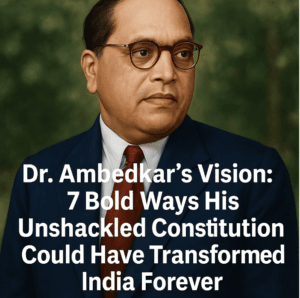Dr. Ambedkar’s Vision: 7 Bold Ways His Unshackled Constitution Could Have Transformed India Forever
Had Dr. B.R. Ambedkar drafted India’s Constitution with unchallenged authority, it would have been a revolutionary manifesto for social justice, economic equity, and secular modernity. Caste annihilation—not mere reform—would dominate: legal bans on caste identity, separate Dalit electorates, and radical land redistribution to dismantle systemic oppression. A socialist framework would nationalize key industries, cap wealth, and enshrine labor rights as non-negotiable guarantees.
Religion’s grip on civil laws would crumble under a mandatory Uniform Civil Code, prioritizing gender justice over orthodoxy. Rejecting Gandhi’s idealized villages, governance would favor urban-centric modernization, balancing federalism with a strong central authority. Expanded rights—to work, education, and minority protections—would be enforceable, not aspirational, while Buddhist ethics of equality and reason would anchor the republic’s moral core.
Though politically contentious, such a Constitution might have accelerated India’s liberation from caste and poverty. Yet, its radicalism risked alienating elites, underscoring Ambedkar’s pragmatic compromise: a foundational document that planted seeds of justice, leaving future generations to nurture its unfinished revolution.

Dr. Ambedkar’s Vision: 7 Bold Ways His Unshackled Constitution Could Have Transformed India Forever
Few figures in India’s history have shaped its democratic ethos as profoundly as Dr. B.R. Ambedkar. While the Indian Constitution remains a monumental achievement, its final form was a product of compromise. But what if Ambedkar had wielded unrestrained authority in its drafting? Drawing from his radical ideals, we explore a transformative blueprint that might have reshaped India’s social, economic, and political fabric.
- Caste Annihilation: Beyond Token Reforms
Ambedkar’s seminal work, Annihilation of Caste (1936), argued that caste was not just a social hierarchy but a systemic tool of oppression. The current Constitution’s abolition of untouchability (Article 17) was a start, but Ambedkar’s vision went further:
- Legal Eradication of Caste Identity: Laws criminalizing caste-based practices, including endogamy and hereditary occupations, to dismantle caste’s structural roots.
- Separate Electorates for Dalits: Revisiting the 1932 Communal Award, he might have institutionalized political autonomy for Dalits, rejecting the Poona Pact’s compromise that left them dependent on upper-caste votes.
- Land to the Landless: Radical land redistribution from dominant castes to Dalit and marginalized communities, transforming economic power dynamics.
- Socialist Foundations: State Control and Equity
Ambedkar’s States and Minorities (1947) outlined a socialist framework far bolder than the Directive Principles:
- Nationalization of Key Sectors: State ownership of agriculture, industry, and banking to prevent capitalist exploitation. Unlike the non-enforceable Article 39, these would be justiciable rights.
- Wealth and Inheritance Caps: Limits on private wealth to curb inequality, ensuring resources were redistributed to uplift the marginalized.
- Labor Rights as Fundamental: Guaranteed living wages, unionization, and state employment mandates to embed economic democracy.
- Secularism with Teeth: Uniform Civil Code
Ambedkar’s disdain for religious orthodoxy was evident in his push for a Uniform Civil Code (UCC). Unburdened by political pragmatism, he might have:
- Abolished Personal Laws: Replaced Hindu, Muslim, and other religious codes with a gender-just secular law, overriding traditionalist opposition.
- Explicit Secular Governance: Barred state funding of religious institutions and mandated secular education to counter caste and communal biases.
- Governance: Central Power vs. Local Realities
While Ambedkar advocated a strong central government to prevent fragmentation, his vision diverged from Gandhi’s rural romanticism:
- Skepticism of Village Republics: Dismissing villages as “dens of casteism,” he might have prioritized urban-led modernization over panchayat systems (contrary to Article 40).
- Balanced Federalism: Fiscal autonomy for states with a central safeguard against disintegration, avoiding the pitfalls of Article 356’s misuse.
- Expanding Rights: From Paper to Practice
Ambedkar sought enforceable guarantees, not aspirational ideals:
- Right to Work and Education: Justiciable entitlements, reducing dependence on policy whims.
- Minority Safeguards: Veto powers for minorities over discriminatory laws and reserved legislative seats.
- Gender Justice: Constitutional mandates for women’s rights in property and marriage, inspired by his thwarted Hindu Code Bill.
- Institutional Integrity: Judiciary and Accountability
- Judicial Independence: Fixed budgets and transparent appointments to shield courts from political interference.
- Anti-Corruption Mechanisms: Citizen oversight bodies to hold bureaucrats and politicians accountable.
- Buddhist Ethos: Ethical Governance
Though Ambedkar embraced Buddhism post-1950, his constitutional preamble might have emphasized:
- Buddhist Principles: Framing democracy around compassion and rationality, prefiguring the 1976 “socialist, secular” insertions.
- Education as Liberation: Free, compulsory education as a fundamental right, aligning with his belief in enlightenment through knowledge.
Feasibility: A Vision Ahead of Its Time?
Ambedkar’s unyielding draft would have faced fierce resistance. Landlords, religious conservatives, and capitalists might have revolted against redistributive policies. Yet, his realism shone in the Constituent Assembly, where he conceded that “however good a Constitution, it is sure to fail if the people are not inclined to respect it.” His final draft balanced idealism with the socio-political realities of a fractured, post-colonial India.
Legacy: The Road Not Taken
Today, as India grapples with caste violence, economic disparity, and religious polarization, Ambedkar’s unrealized vision offers a mirror to its unfinished revolution. While the adopted Constitution secured stability, his radical blueprint underscores the enduring gap between India’s democratic promises and its lived realities—a call to reimagine equity in the 21st century.
In Retrospect
Had Ambedkar’s free-hand Constitution emerged, it might have accelerated social justice but tested national cohesion. Yet, its spirit persists in grassroots movements and legal battles, reminding us that constitutions are not static texts but living aspirations.
You must be logged in to post a comment.